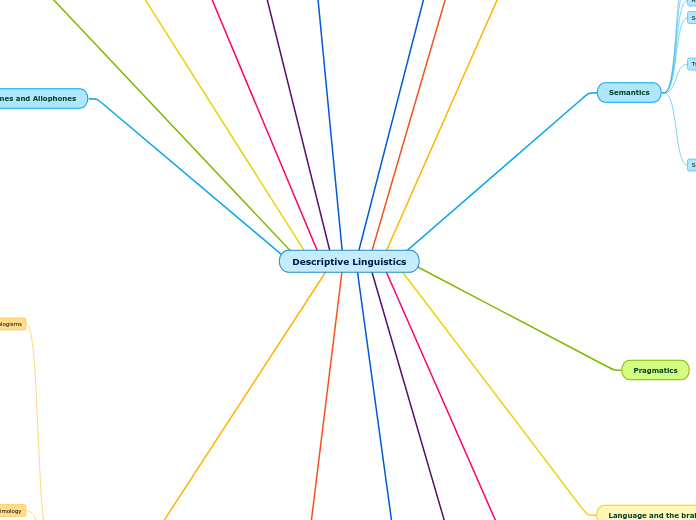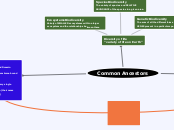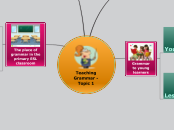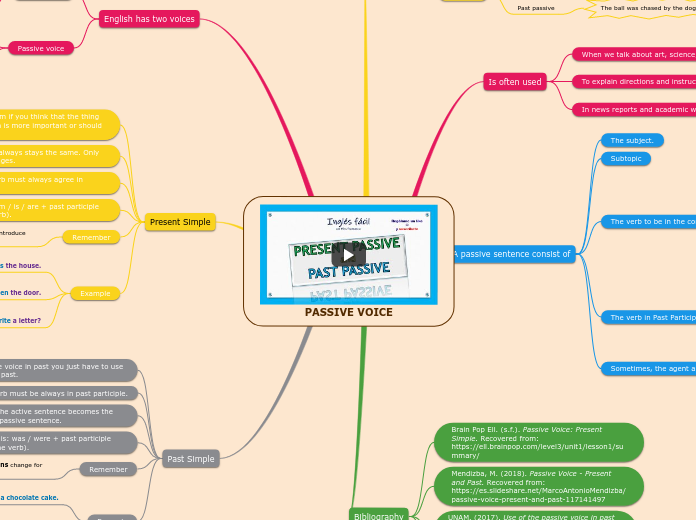Descriptive Linguistics
VERBS
Intransitive
Transitive
Second language acquisition.learning
First language acquisition
Language and the brain
Pragmatics
Semantics
Semantic roles
Situation describes by a sentence
Goal: to Quito
Source: from France
Location: next to the computer
Experiencer: related to a feeling
Instrument: The tool that helps the agent
Theme: object
Agent: Person who executes the action
Types of sentences
Declarative (.)
Exclamatory (!)
Imperative (!)
Interrogative (?)
Semantic features
Categories that classify the meaning of a word
Associative meaning
Concepts that we add
Conceptual meaning
Meaningful function of the Word
Analyzes the meaning and interpretation of the words
Syntax
Structure
Part of speech, phrase structure grammar, and sentences
Subject + verb+ object
Parts of speech
Noun, verb, pronoun, adverb, adjective, preposition, conjunction and article
Categories
Help another word ex: the, this, will, etc
Add new words, ex: policy, good, now, etc
Based on components and rules
How sentences are formed and interpreted
Grammar
Descriptive Approach
Describes the language as it is
actually used
Prescriptive Approach
How language is really used
Traditional grammar
Origin of the description of the languages
Is a language system
Composed of rules, clauses, phrases, and
words
How words are formed
Acronyms
GG
Good Game
BAE
Before Anyone Else
PIN
Personal Identification Number
ASAP
As Soon As Possible
Shortened forms use for the communication
Combined letters
Is the process when we reduces words and put only initial letters
First few letters
Dipping
Photograph
Photo
Influence
Flu
Brother
Bro
Telephone
Phone
The word is reduced but still has the same meaning.
The
meaning is not removed
Syllables are removed
The end or the beginning of words is reduced or cut
Blending
Glamour
+ritz
Glitz
Motor+hotel
Motel
Web+log
Blog
They
join two separate words to produce a new form by combining.
The initial part of a word is joined with the final part of
another
The initial parts of both words
Compunding
There are three ways to write compound words
Hyphenated Compounds
Close-up
Closed Compounds
Grandfather
Open Compounds
Fool moon
These words are derived from the lexemes
Two different
words are joined
one with its own meaning
Creating new words
Word Formation
Borrowing
Oral Speech
The words is adopting
Early period
Contact with the people
Written Speech
A long process for assimilation
Recent Time
Indirect contact
Spealling is conserved
Consequence of cutural contact
New words are formed the addopted to english from other languajes
English adopted words the other languajes
Etimology
Words that are modified to the standard of English
Earlist available
Belong to the original
Old english period
Words from the other languajes
Meaning
Paradigm
Spealling
Phonemic shape
The changes that meanings have
Where the words are from?
Study the origin of new words
From many other lenguajes
Inlfuence
Latin
Greek
Neologisms
It is used by native speakers and then implemented in active vocabularies
It is used in specific context
Languaje Conection
Ne phonome
New concept
Recently created
Phrase
Word
Words created in one language and entered in another with different meanings.
Phonemes and Allophones
Minimal Pairs
Examples
/v/
Van
/f/
Fan
Are two words that vary by only a single sound
Allophones
They are written in brackets
[p]
[t]
Non-significant
Predictable
Variations within each group of phoneme
Phoneme
Makes works
Note that slash marks / /
/p/
/t/
Functions contrastively
Smallest unit
Distinguishes meaning
Phones or set of sounds
The sounds of
patterns of language
Phonemes
The minimal unit of sounds
Phonology
Involves
Phonemics
Sound Patterns
Sounds
Phonetics
Reception
Transmission
Produccion
Aspect
Mental
Abstract
Sounds Functions
Is the study of the sound
Charting consonant
sounds
Manners of
articulation
Lateral
No contact between active (tongue) and passive articulator
Glides
there are no contacts between articulators
Affricative
Consonant sounds that begin by fully stopping
the air from leaving the vocal tract
Fricative
A consonant sound, such as English f or v
Nasal
It is produced with a lowered velum in the mouth
Plosive
The airstream cannot escape through either the mouth or nose
The sounds of
language
Place of
articulation
Glottal
This isn't strictly a place of articulation, but
they had to put it in the chart somewhere
Velar
The active articulator = the tongue body
the passive articulator = the soft palate.
Palatal
The active articulator = the tongue body
the passive articulator = the hard palate.
Retroflex
The tongue tip is curled up and back
Postalveolar
The area behind the alveolar ridge
as the passive articulator
Alveolar
The alveolar ridge as the passive articulator
Dental
The upper teeth = the passive articulator
The tongue = the active articulator.
Labio-dental
The lower lip = the active articulator
the upper teeth = passive articulator
Bilabial
The articulators are the two lips
Animals and Humans
Language
Properties of
Language
Duality
The users can produce a large combinations of sounds.
Discreteness
The sounds used in language.
Cultural Transmission
Language that must be learned by each new generation.
Productivity
Production of new expressions
Arbitrariness
connection between the nature of the
ideas and combination of words
Displacement
Ability to produce a message
The Origins of
Language
The physical adaptation Source
The Social Interaction Source
Language originated from song
as an expressive rather than a
communicative need.
The Natural Sound Source
It's the language emerged
from natural sounds.
The divine Source
A divine source who provided humans with language
Morphology
FREE Morphemes
Functional
CLOSED:
gramatical
function.
Lexical
OPEN: can
add
morphemes.
Definition
Study the
formation
and parts of
words.
BOUND Morphemes
Inflectional
Aspects of
gramatical
Derivational
Change the
part of a Word









